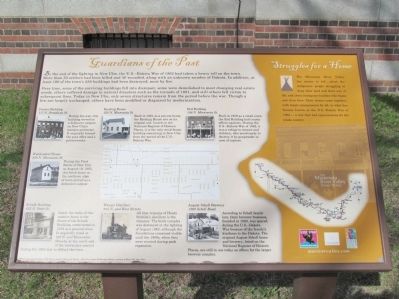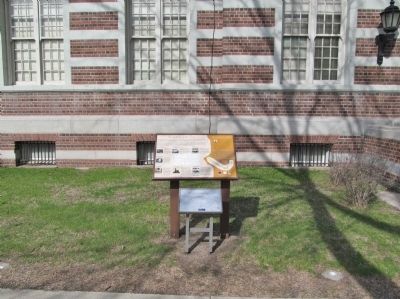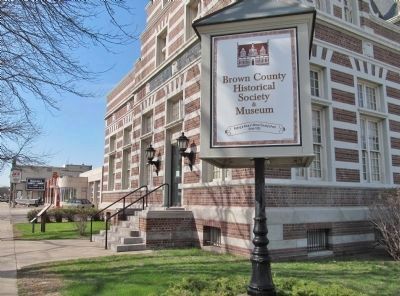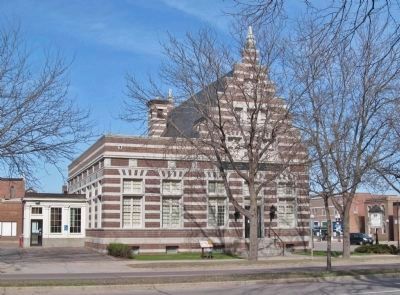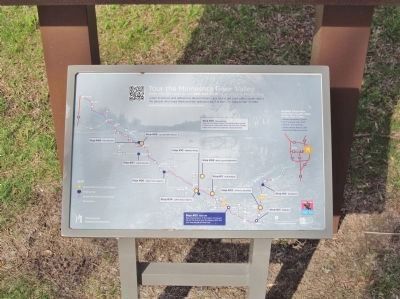New Ulm in Brown County, Minnesota — The American Midwest (Upper Plains)
Guardians of the Past
By the end of the fighting in New Ulm, the U.S.—Dakota War of 1862 had taken a heavy toll on the town. More than 50 settlers had been killed and 36 wounded, along with an unknown number of Dakota. In addition, at least 190 of the town’s 258 buildings had been destroyed, most by fire.
Over time, some of the surviving buildings fell into disrepair, some were demolished to meet changing real estate needs, others suffered damage in natural disasters such as the tornado of 1881, and still others fell victim to subsequent fires. Today in New Ulm, only seven structures remain from the period before the war. Though a few are largely unchanged, others have been modified or disguised by modernization.
Forster Building
117 N. Broadway St.
During the war, this building served as a defensive outpost on New Ulm's western perimeter. It originally housed the post office and a potteryworks.
Kiesling House
220 N. Minnesota St.
Built in 1861 as a private home, the Kiesling House sits on its original site. Listed on the National Register of Historic Places, it is the only wood-frame building remaining in New Ulm from the period of the U.S.—Dakota War.
Erd Building
108 N. Minnesota St.
Built in 1858 as a retail store, the Erd Building had county offices upstairs. During the U.S.—Dakota War of 1862, it was a refuge to women and children, who stood ready to destroy it by gunpowder in case of capture.
Weddendorf House
826 N. Minnesota St.
During the First Battle of New Ulm on August 19, 1862, this brick home on the northern edge of town served as a defensive outpost.
Schalk Building
822 N. State St.
Inside the walls of this modern home is the frame of the Schalk Building, constructed in 1858 as a general store. It originally stood at 3rd N. and Minnesota Streets, at the north end of the barricades erected during the 1862 war to defend the town.
Waraju Distillery
2nd N. and West Streets
All that remains of Henry Sublilia's distillery is the chimney. The brick complex was destroyed in the fighting of August 1862, although the foundations remained visible until the 1960s, when they were covered during park expansion.
August Schell Brewery
1860 Schell Road
According to Schell family lore, their brewery business, founded in 1860, was spared during the U.S.—Dakota War because of the family’s kindness to the Dakota. The original August Schell home and brewery, listed on the National Register of Historic Places, are still in use today as offices for the larger brewery complex.
Photos from the collection of the Brown County Historical Society, New Ulm, except Weddendorf House, courtesy of Elroy Ubl, New Ulm
Struggles for a Home
The Minnesota River Valley has stories to tell...about the indigenous people struggling to keep their land and their way of life, and about immigrant families who began new lives here. Their stories came together, with tragic consequences for all, in what has become known as the U.S.–Dakota War of 1862 — a war that had repercussions for the whole country.
logos of: Scenic Byway Minnesota River Valley; Minnesota Historical & Cultural Grants; Clean Water Land & Legacy Amendment
mnrivervalley.com
This project has been made possible by the Arts and Cultural Heritage Fund through the vote of Minnesotans on November 4, 2008. Administered by the Minnesota Historical Society.
Erected 2012 by the Minnesota River Valley National Scenic Byway.
Topics and series. This historical marker is listed in these topic lists: Settlements & Settlers • Wars, US Indian. In addition, it is included in the Minnesota Historical Society series list. A significant historical month for this entry is November 1929.
Location. 44° 18.777′
N, 94° 27.626′ W. Marker is in New Ulm, Minnesota, in Brown County. Marker is at the intersection of Broadway (State Highway 15 / 68) and Center Street on Broadway. Marker is to the left of the Broadway entrance of the Brown County Historical Society & Museum. Touch for map. Marker is at or near this postal address: 2 North Broadway, New Ulm MN 56073, United States of America. Touch for directions.
Other nearby markers. At least 8 other markers are within walking distance of this marker. U.S. Post Office (within shouting distance of this marker); Somsen Hitching Post (within shouting distance of this marker); The George Kuhlman House (within shouting distance of this marker); Arbeiter Hall (about 300 feet away, measured in a direct line); Two Battles of New Ulm (about 300 feet away); Herman’s Footprint (about 300 feet away); Brown County Bank (about 400 feet away); Boesch, Hummel, and Maltzahn Block (about 400 feet away). Touch for a list and map of all markers in New Ulm.
More about this marker. In August 1862, the Minnesota Dakota, also known by the French term, “Sioux," waged war against the United States following two years of unfulfilled treaty obligations. After attacking the Redwood (Lower Sioux) Agency, a remote government outpost, the Dakota moved with speed and surprise across southwestern Minnesota and what was then eastern Dakota Territory, killing nearly everyone in their path. They killed approximately
800 settlers and soldiers, took many prisoners, and caused extensive property damage throughout the Minnesota River Valley.
Also see . . .
1. 1862 Dakota War. "It was the largest Indian war in American history. The main battleground was the entire Minnesota River Valley in southern and central Minnesota. The uprising spread into the Dakota Territories and sent panic into Nebraska, Iowa and Wisconsin. In Minnesota, Indians did mass attacks on a fort and an entire town - both twice. Contrary to what folklore and Hollywood tell us, this was almost unheard of in any of the Indian campaigns....New Ulm was on good terms with the Dakota, who freely mingled in the streets and businesses. The day the war started, it was a prosperous, peaceful town of about 900 people and almost 300 buildings. A week later, it was deserted and burned to the ground." (Submitted on May 31, 2014.)
2. The US-Dakota War of 1862. (Submitted on May 31, 2014.)
3. Minnesota River Valley Scenic Byway. (Submitted on May 31, 2014.)
Credits. This page was last revised on October 21, 2020. It was originally submitted on May 31, 2014, by Keith L of Wisconsin Rapids, Wisconsin. This page has been viewed 1,053 times since then and 43 times this year. Last updated on June 1, 2014, by Keith S Smith of West Chester, Pennsylvania. Photos: 1, 2, 3, 4, 5. submitted on May 31, 2014, by Keith L of Wisconsin Rapids, Wisconsin. • Bill Pfingsten was the editor who published this page.
